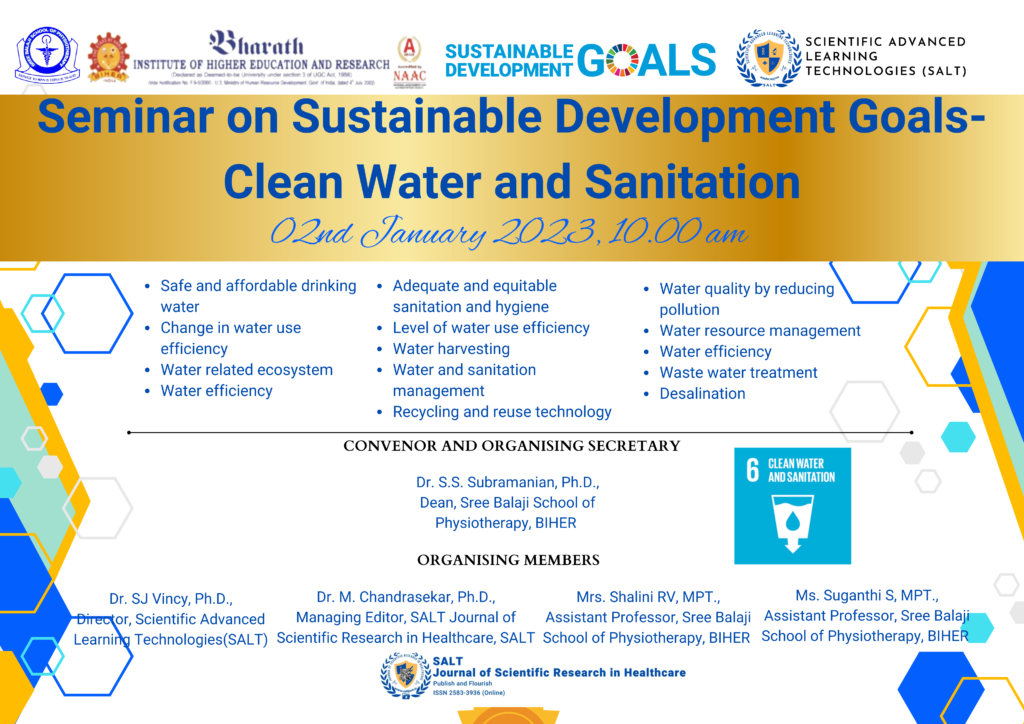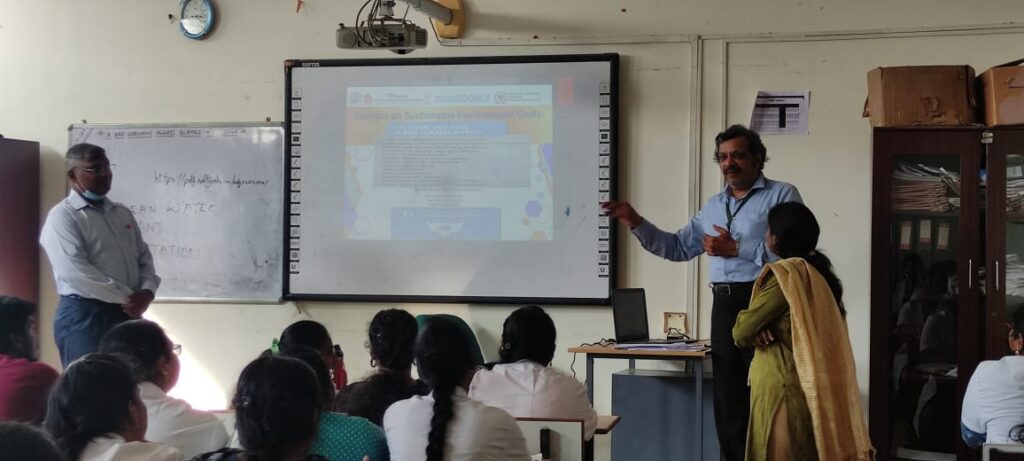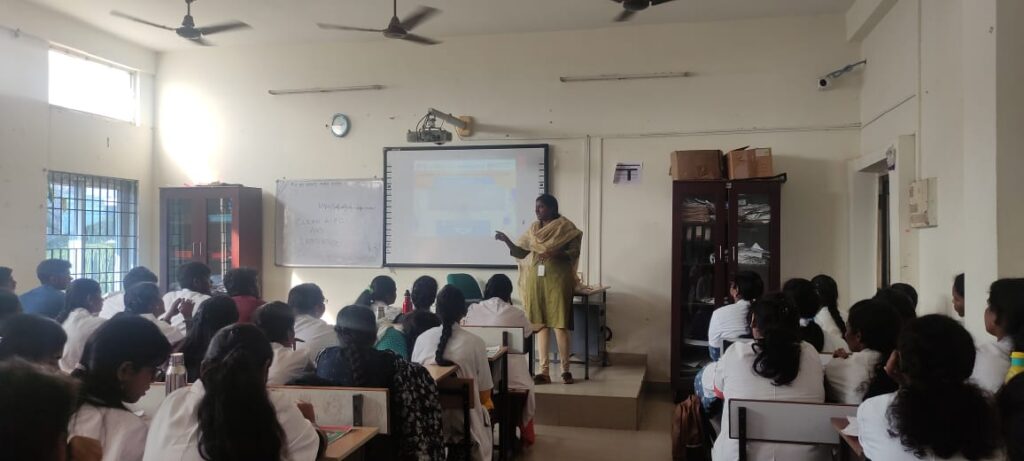SEMINAR ON SUSTAINABLE DEVELOPMENT GOALS- CLEAN WATER AND SANITATION
Dr S.S.Subramanian, Dr SJ Vincy, Dr M Chandrasekar, Mrs Shalini RV and Ms S Suganthi



ABSTRACT OF PRESENTATIONS
Wastewater treatment
S Indhumathi, BPT 3rd year, Sree Balaji School of Physiotherapy (BIHER)
Wastewater treatment is process to treat sewage or wastewater to remove suspended solids and convert them into effluent that can be discharged into environment with acceptable impact. According to SDG, 56 percentage of world’s domestic wastewater is safely treated. Wastewater treatment process includes PRELIMINARY treatment mainly minimize the operational problems. PRIMARY treatment is to remove the materials that either float or readily settle out by gravity. SECONDARY treatment is the substantial elimination of dissolved organics and colloidal materials. TERTIARY treatment which removes the pollutants by other methods. It has very high effectiveness. The process has eight stages includes: bar screening, screening (removal of grit), Primary califer, aeration, secondary califer, chlorination, water testing and effluent disposal.
WATER QUALITY BY REDUCING POLLUTION
Mamidi Vijay Veer, BPT 3rd year, Sree Balaji School of Physiotherapy (BIHER)
Water quality is one of the main challenges that societies will face during the 21st century. The availability of the world’s water resources is limited due to the pollution of freshwater resources caused by the disposal of insufficiently treated wastewater into rivers, lakes, aquifers and coastal waters.
The 2030 Agenda and Sustainable Development Goals (SDGs) bring water quality issues to the forefront of international action by setting Goal 6 specifically aiming to “ensure availability and sustainable management of water and sanitation for all” to respond to the pressing challenges posed by water quality issues.
Water quality is addressed also under other SDGs such as the goals on health, poverty reduction, ecosystems and sustainable consumption and production, recognizing the links between water quality and the key environmental, socioeconomic and development issues.
The clear focus on water quality in the SDGs demonstrates growing attention on the urgent need to improve water quality worldwide.
Water Harvesting
A. Darshika, BPT 3rd year, Sree Balaji School of Physiotherapy (BIHER)
Rainwater harvesting system (RWHS) carries a huge potential as an alternative strategy to cope with drinking water scarcity. RWHS becomes economically feasible when certain steps and risk assessment procedures are implemented in designing and maintaining this system. Drinking water sufficiency is possible if a sustainable drinking water supply system is established via RWHS. RWH system offers sufficient amount of water and energy savings through lower consumption. Moreover, considering the cost for installation and maintenance expenses, the system is effective and economical. The reliability of RWHS depends on the rainfall pattern and duration of the dry period, and these boundaries would differ with climate change. Moreover, the seasonal and inter-annual inconsistency of rainfall and ecological distributions are other areas that can be affected by climate change. These probable discrepancies in rainfall and rise in temperature are probably going to worsen water deficiency conditions around the world in the future.
Safe And Affordable Drinking Water
Nisharani Pati, BPT 3rd year, Sree Balaji School of Physiotherapy (BIHER)
- It is quintessential to know that the water we are drinking are actually safe for us Or not and also is it affordable for everyone. If it looks clean they assumes that this is safe to drink, but the water looking clean might not always safe to drink.
- According to NSSO(2021, 76th round) all over the India , the rural areas are using water of about 42.9% by handpump and the urban areas are using water of about 40.9% by piped water. So the Bureau Of Indian Standards has specified the quality of drinking water to provide sage water to the citizens.
- ACC to BIS, the test protocol are to be followed regularly, through which the water qualities, PH are regularly tested.
- So after all, the SDG Water Affordability Goal Chart says that, by 2023 achiever universal and equitable access to safe and affordable drinking water for all.
ADEQUATE AND EQUITABLE SANITATION AND HYGIENE
Asha B, Sree Balaji School of Physiotherapy (BIHER)
Basic sanitation is defined as having access to facilities for the safe disposal of human waste (feces and urine), as well as having the ability to maintain hygienic conditions. Some 829 000 people in low- and middle-income countries die as a result of inadequate water, sanitation, and hygiene each year, representing 60% of total diarrhoeal deaths. Poor sanitation is believed to be the main cause in some 432 000 of these deaths and is a major factor in several neglected tropical diseases, including intestinal worms, schistosomiasis, and trachoma. Poor sanitation also contributes to malnutrition.
Open defecation perpetuates a vicious cycle of disease and poverty. 1,829,000 people in low- and middle-income countries die as a result of inadequate water, sanitation, and hygiene each year representing 60% of total diarrhoeal deaths (Barbara Evans et al., Journal of Water, Sanitation and Hygiene for Development, 2017).
Recycling and reuse technologies
Madhumitha. B. M, B.P.T IIIrd Yr, Sree Balaji School of Physiotherapy (BIHER)
Reuse of treated wastewater is one of the most promising water management strategies, which serves the two-fold purpose of augmenting water resources as well as reducing the environmental impacts of disposal of untreated wastewater (Pereira et al., 2002; Massoud et al., 2018).
The per capita availability of water in India is estimated to fall towards 1,100 cubic meters by It was 1,800 cubic meters per year in 2001. Water used for sanitation purposes is rarely recycled in India’s urban areas, and as per survey reports merely 30 per cent of India’s wastewater is recycled. Our country lacks proper financing and designs for the wastewater recycling infrastructure, especially urban areas. The sewage systems have not been designed as per global standards, and most of the urban India’s sewage systems lead directly to rivers or lakes, without treatment.
As per the estimates, the anticipated water demand would be 1498 billion cubic meters (BCM) by the year 2030, contrary to the expected water availability of 744 BCM, creating a huge gap between the demand and availability (NITI Aayog 2018). By 2030, improve water quality by reducing pollution, eliminating dumping and minimizing release of hazardous chemicals and materials, halving the proportion of untreated wastewater and substantially.
Desalination
Nivetha. R, B.P.T IIIrd Yr, Sree Balaji School of Physiotherapy (BIHER)
Desalination is the removal of salts from sea water or brackish water to produce drinking water. Saudi Arabia is the leading desalination country by volume, followed by the United Arab Emirates. The process of desalination include Reverse osmosis, multi stage flash, distillation, electro dialysis and multi effect distillation. The first large-scale desalination plant was built in 1930 at Aruba, in the Netherlands Antilles, near Venezuela. For getting 100 MLD of Potable water, about 237 MLD of seawater is drawn. The Minjur desalination plant is the first and largest desalination plant in India, which is located at Katupalli village near Chennai. As we all know clean water and sanitation plays a vital role in the fundamental human health; and also for achieving the Sustainable development goals (SDG’s), to reach the destination as well to progress all the 17 SDG’s nutrition aids.